Browsing participants
The primary way to browse participants in APLS is via the Participants page: https://apls.pitt.edu/labbcat/participants.
The Participants page lets you view, filter, and export information about the participants in APLS. On this documentation page, we cover the functionality and layout of the Participants page.
On this page
What you can do on the Participants page
The Participants page allows you to…
- View demographic information for participants.
- Filter participants according to certain criteria.
- Export participant data in a variety of formats.
- Select participants to search.
Layout
Participant list
The participant list displays all participants in APLS that match your filter criteria.
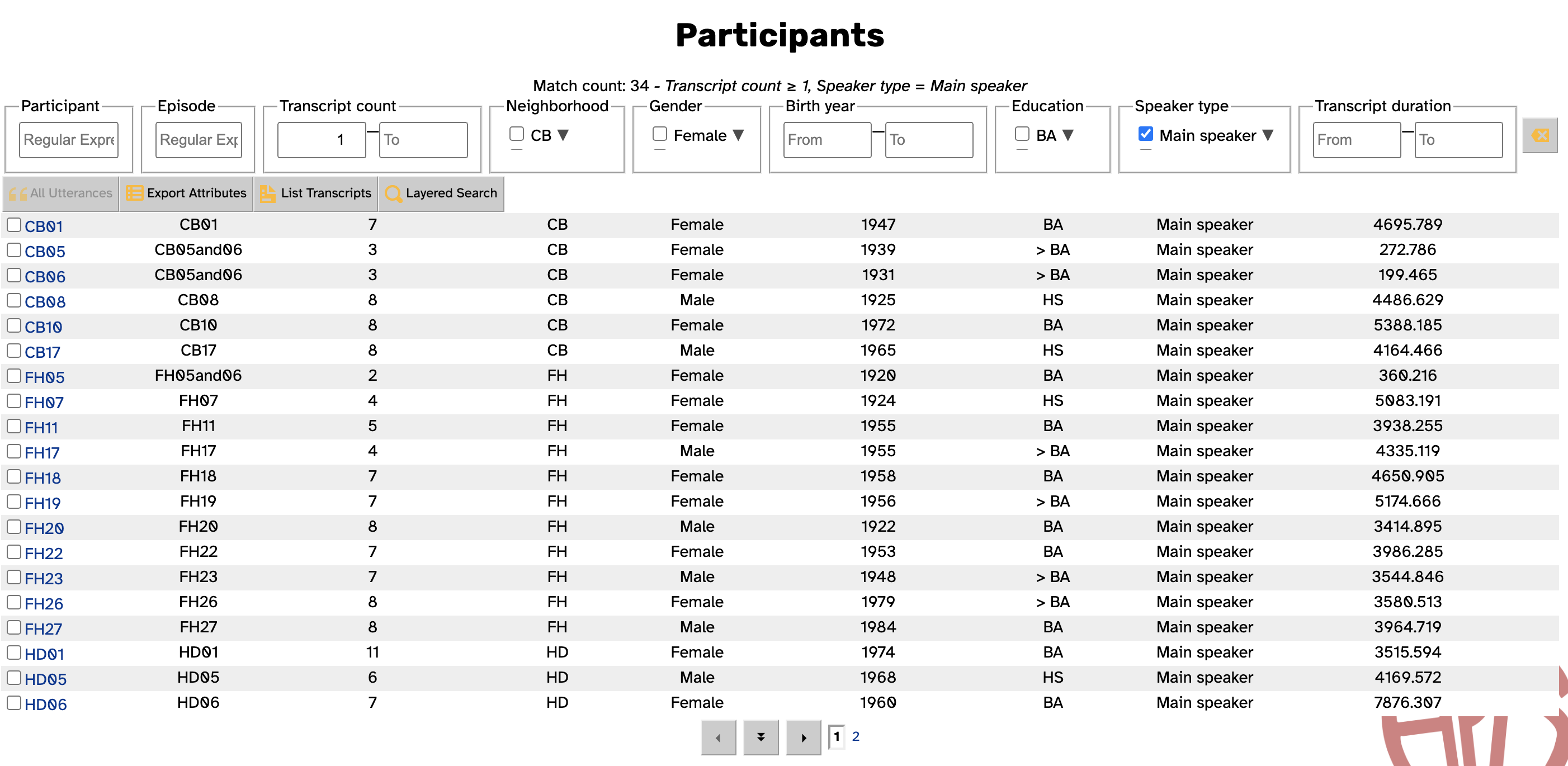
The columns in the participant list, from left to right, are:
- A checkbox that can be toggled on to have the participant included in Export menu options.
- The code or name of the participant.
- Clicking the participant code will open the corresponding Participant attributes page.
- The episode code associated with the participant.
- The number of transcripts for that participant.
- The neighborhood where the participant was recruited from.
- The participant’s gender.
- The participant’s year_of_birth.
- The participant’s education level.
- The participant’s speaker type.
- The total transcript_duration (measured in seconds) for that participant.
You can read more about participant attribute data in the field guide.
Filtering participants
The filter menu at the top of the Participants page lets you find participants that match certain criteria.

Underneath the Participants heading is the match count, which shows the number of participants that currently fit the criteria of your filters.
The default filter for the Participants page is to show all participants categorized as a “Main speaker” who have at least 1 transcript in APLS. As shown above, there are 34 participants in APLS who meet this criteria.
The nine filter fields correspond to the columns in the participant list directly below the filter fields:
-
The “Participant” and “Episode” text fields filter participants by participant code or episode code1 using regular expressions.
Go to the Participants page and enter
.+and.+into the “Episode” text field. This will display all participants with an episode code that is a combination of multiple participant codes. - The “Transcript count” text fields filter participants by their total number of transcripts in APLS.
- To view participants with…
- at least
Xtranscripts: enterXin the From box (leave To blank) - at most
Ytranscripts: enterYin the To box (leave From blank) - between
XandYtranscripts (inclusive): enterXin the From box andYin the To box
- at least
- The default for this filter is set to show all participants with at least 1 transcript in APLS.
Go to the Participants page and enter
10into the From text field and leave the To text field blank. This will show all participants with at least 10 transcripts in APLS.In the same way, you can leave the From text field blank and enter
3in the To text field to show all participants that have 3 transcripts or less in APLS.Some participants have 0 transcripts. We’re still transcribing their interviews, and we’ve pre-uploaded their participant attributes. Version 1.0 of APLS will include all of these participants.
- To view participants with…
- The “Neighborhood” multi-choice menu filters participants by the Pittsburgh neighborhood where the participant was recruited from.
- You can view full option descriptions by hovering over the options in the dropdown menu.
-
The “Gender” multi-choice menu filters participants by gender.
All speakers in APLS self-identified as either women or men at the time of recording.
- The “Birth year” text fields filter participants by their year_of_birth.
- The From and To ranges for this filter can be used with one value or two values, similar to the “Transcript count” filter.
-
The “Education” multi-choice menu filters participants by their level of education at the time of the recording.
Go to the Transcripts page and select BA and > BA from the Education drop-down list. This will display all participants who completed a 4-year undergraduate degree of some sort, as well as participants who had some graduate level education.
- The “Speaker type” multi-choice menu filters participants by their speaker type.
- The default for this filter is set to show only participants who are categorized as main speakers.
- The “Transcript duration” text fields filter participants by the total transcript_duration (measured in seconds) associated with that participant.
- The From and To ranges for this filter can be used with one value or two values, similar to the “Transcript count” filter.
Clearing filters
The “delete” button () allows you to clear all currently specified filters.
This button will also clear the default transcript count and speaker type filters, allowing you to view all participants in APLS.
Exporting and searching participant data
The export menu allows you to download and search data associated with participants via different pages. The export menu is located below the filter menu.

Export Attributes
The Export Attributes option allows you to download participant data, transcript data, and media files for selected participants.
If no participants are selected, the Export Attributes option will include all participants that match your current filter criteria.
Clicking Export Attributes will bring up the Export participant data page, which has three different tabs.
participant attributes
participant attributes is the first tab on the Export participant data page.
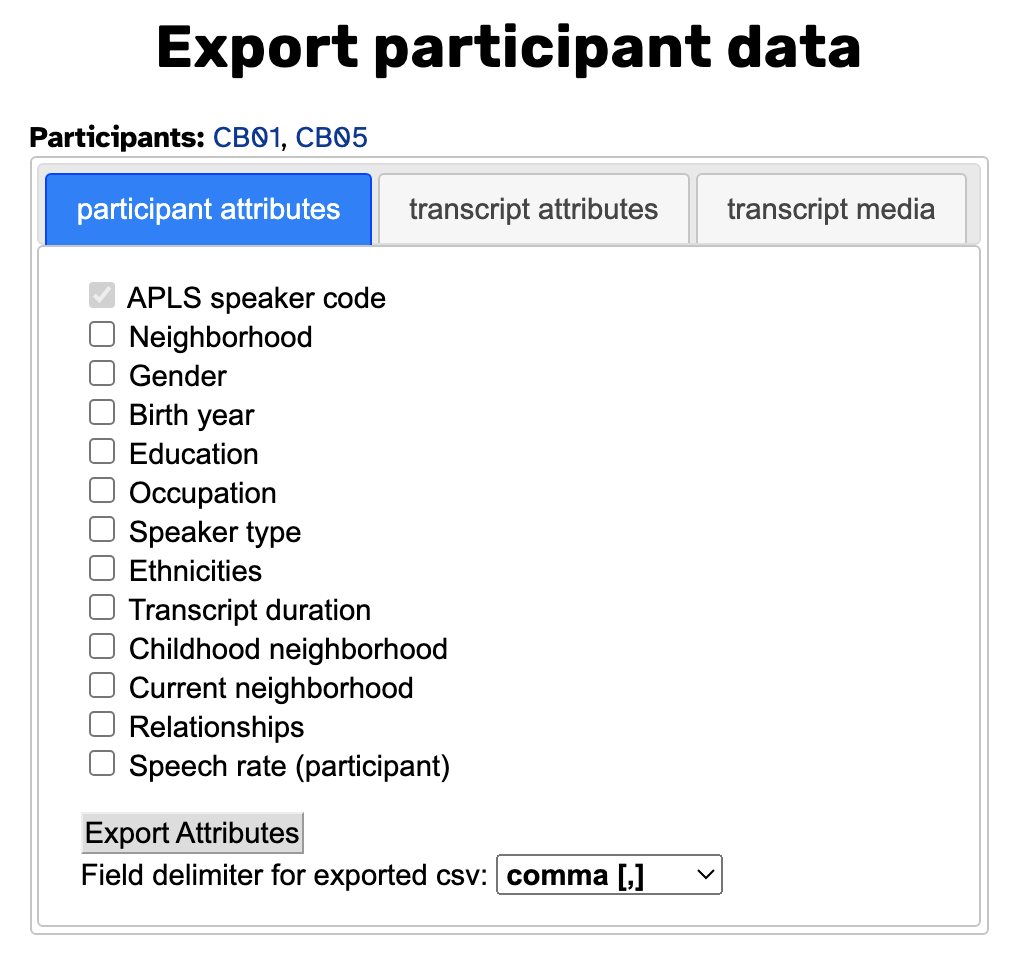
This tab allows you to export participant attribute data according to the attribute fields you select.
APLS speaker codes are always included in the exported file, which is why the checkbox is grayed-out.
After selecting the attributes you would like to export, clicking the Export Attributes button will download a .csv with the selected data. By default, the .csv uses commas as field delimiters, but you can use the drop-down menu to export the .csv with semicolon delimiters or tab delimiters.
Participant attribute data is explained in more detail in the field guide.
transcript attributes
transcript attributes is the second tab on the Export participant data page.
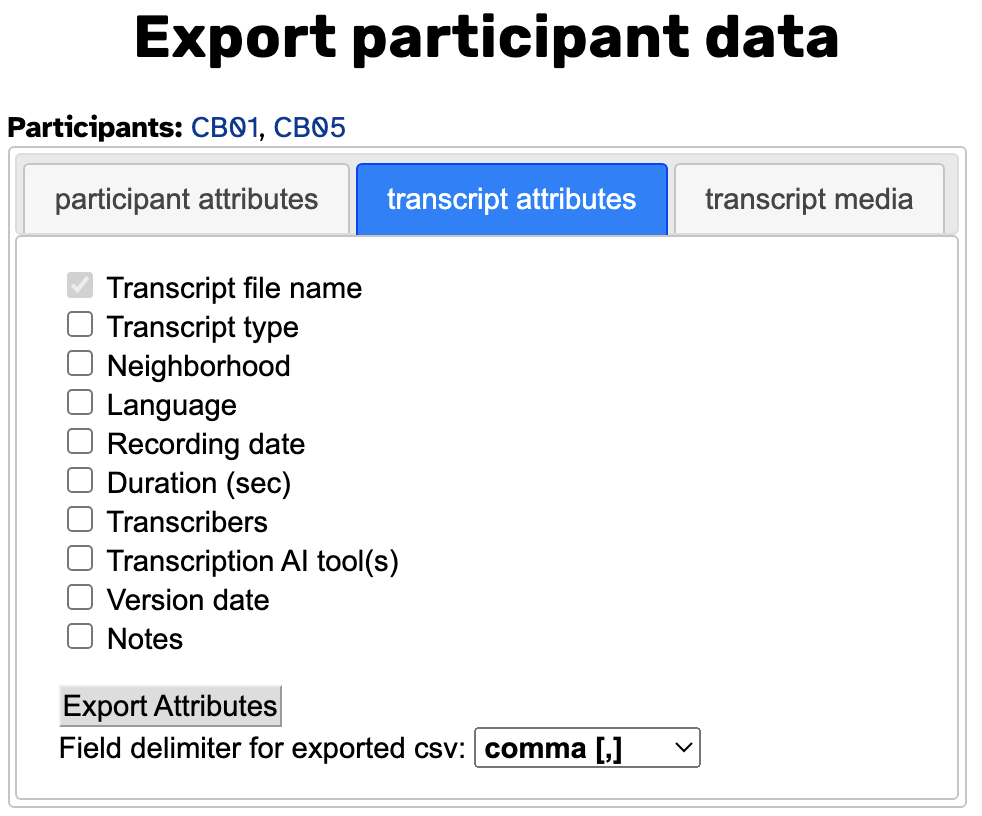
This tab allows you to export participants’ transcript attribute data according to the attribute fields you select.
Transcript file names are always included in exported file, which is why the checkbox is grayed-out. At least one additional attribute must be selected to export transcript data.
After selecting the attributes you would like to export, clicking the Export Attributes button will download a .csv with the selected data. By default, the .csv uses commas as field delimiters, but you can use the drop-down menu to export the .csv with semicolon delimiters or tab delimiters.
A detailed description of the different transcript attributes can be found in the field guide.
transcript media
transcript media is the third tab on the Export participant data page.
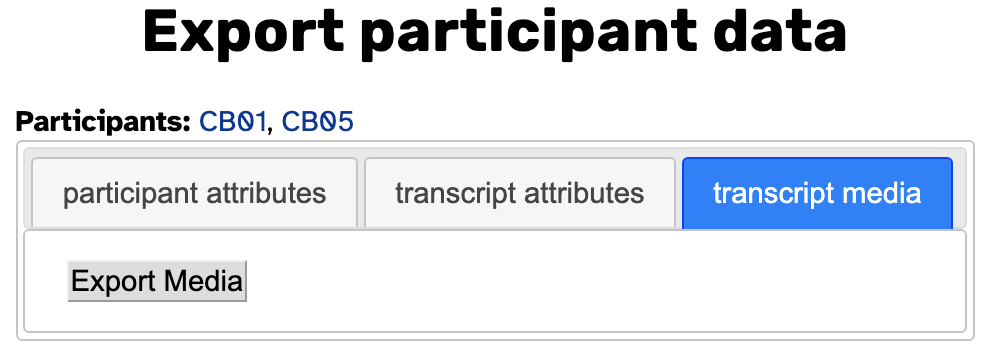
This tab allows you to export all recordings for the selected participants as a .zip file by clicking the Export Media button.
List Transcripts
The List Transcripts option allows you to view all transcripts for the selected participants on the Transcripts page.
The features of the Transcripts page are explained in more detail on the Browsing transcripts documentation page.
Layered Search
The Layered Search option will open the Search page with the selected participants in the Participants search filter field. This allows you to use any of the search capabilities described on the Searching the corpus documentation page with the selected participants.
If no participants are selected, the Layered Search option will include all participants that match your current filter criteria.
- Go to the Participants page.
- Click the checkbox next to CB01 and
Shift+Clickthe checkbox next to FH05 to select the first five participants.- Click Layered Search to open the Search page.
- Enter
yinzinto the Regular expression text field in the orthography section and click Search.- Click Display results to view all utterances of the word
yinzin the transcripts for the five selected participants.
Participant attributes pages
Clicking a participant code will open the corresponding Participant attributes page. This page includes more information about the participant than what is displayed on the main Participants page, as well as links to data associated with the participant.
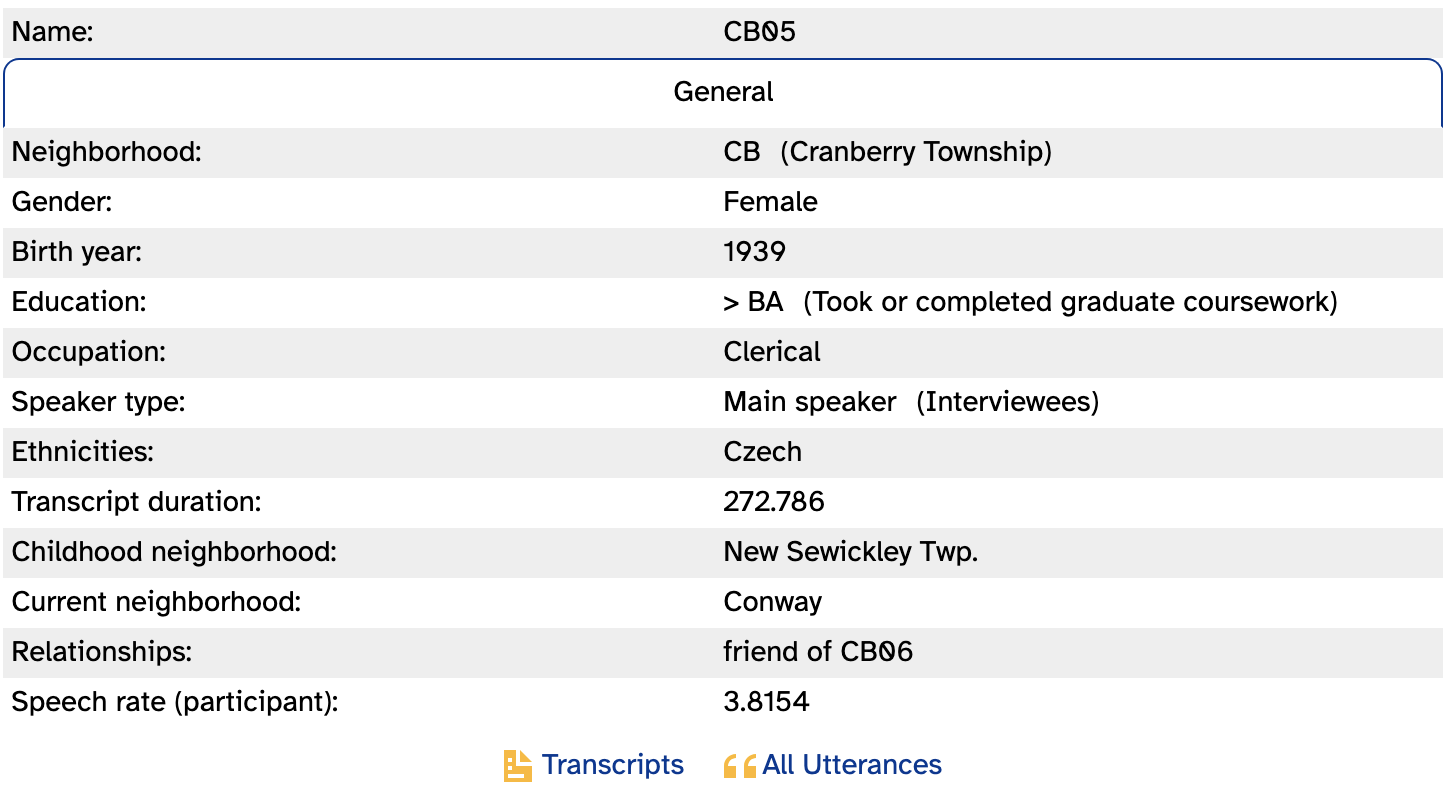
The Transcripts hyperlink will open the Transcripts page for that participant’s transcripts.
The All Utterances hyperlink will open the “All Utterances” page for that participant.
- Go to the Participants page
- Click CB10 to view CB10’s Participant attributes page.
- Click All Utterances to open the “All Utterances” page for CB10.
- Click the checkboxes next to “interview”, “reading”, and “metalinguistic” to deselect them.
- Click List and wait for the search to be completed.
- After the search is complete, click Display results.
- This will show all of CB10’s utterances that occured in “pairs” type transcripts.
Detailed descriptions of participant attributes can be found in the field guide.
-
Most episode codes correspond to a single “Main speaker” participant code, but there are some episode codes that are combinations of multiple participant codes. These episode codes are for sociolinguistic interviews with multiple main speakers; however, the transcripts currently in APLS are for recordings where only one “Main speaker” is present. ↩
